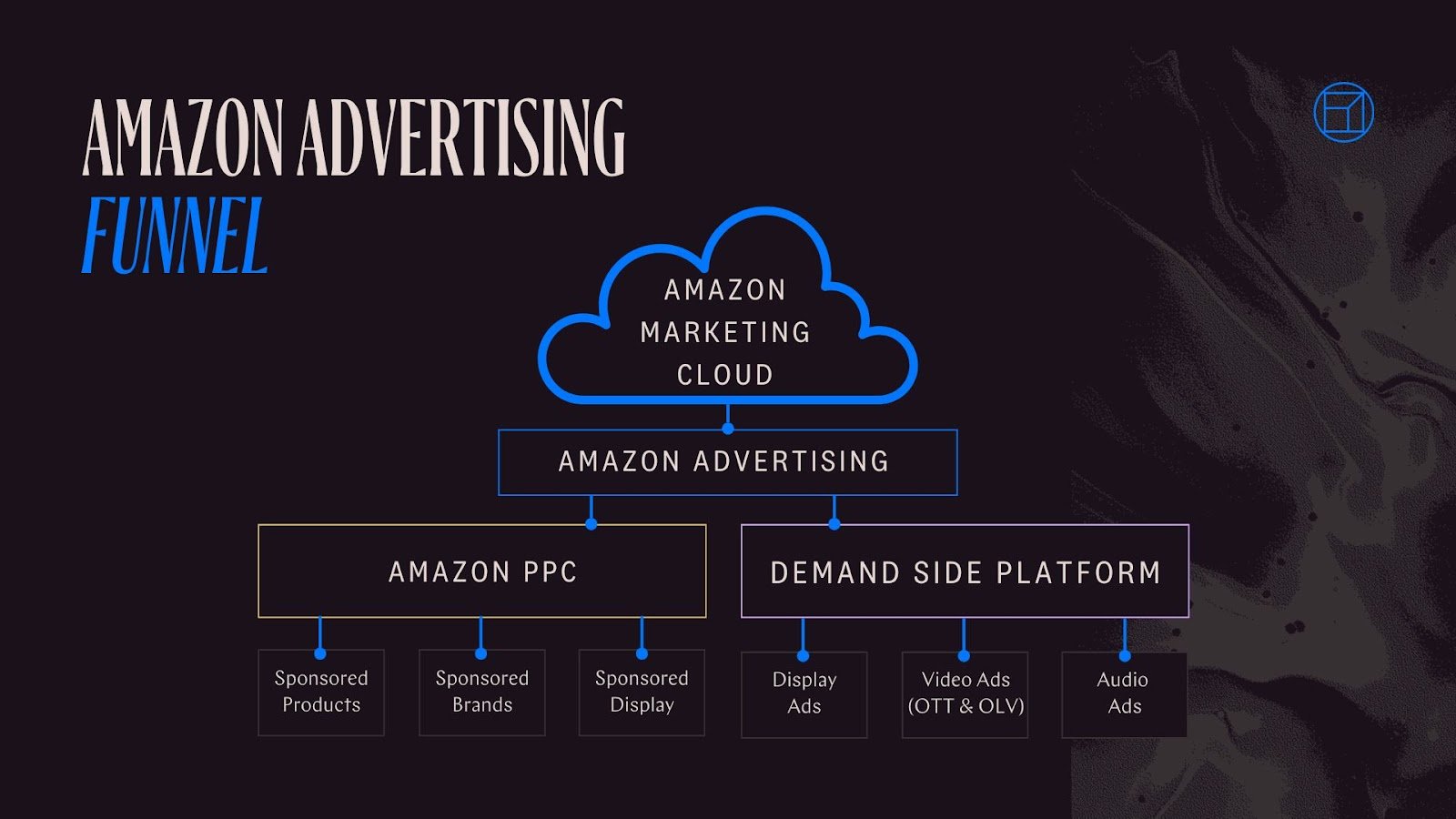If you're selling and advertising on Amazon, you're familiar with the various Amazon Ads advertising solutions available on the platform, such as Sponsored Products, Sponsored Brands, and Sponsored Display ads. Depending on your brand’s size and advertising budget, you might consider incorporating the Amazon Demand Side Platform (DSP) into your strategy or you may already actively use it. To maximize the potential of Amazon DSP, and with the latest update, of your sponsored ads campaigns as well, you'll want to combine them with Amazon Marketing Cloud (AMC).
Keep reading to discover more about Amazon Marketing Cloud and AMC Audiences. In this blog post, you will learn how to utilize this innovative Amazon tool to create custom audiences (AMC Audiences) and effectively reach your customers at the right time and place in their purchase journey.
If you want to dive into AMC even more, watch our webinar, Creating a Winning Strategy with Amazon Marketing Cloud and DSP.
What Is Amazon Marketing Cloud (AMC)?
Amazon Marketing Cloud (AMC) was introduced in 2021. It is a secure, privacy-safe, data clean room solution built on Amazon Web Services (AWS). A data clean room is a privacy-friendly and safe place where different data sets can be merged and queried to identify unique users across multiple data sets. AMC is an advanced holistic measurement and analytics tool where you can structure custom queries to explore unique measurement questions, easily perform analytics across pseudonym signals to address top brand priorities, and build custom audiences for advertising campaigns.
The key benefit of Amazon Marketing Cloud is that it offers in-depth insights into customer behavior and advertising attribution by integrating multiple sources of data (Amazon’s and advertisers' data). The combined data output is often more valuable than the individual datasets alone. In AMC, Amazon serves both as the data clean room host and one of the data providers.

AMC is a powerful tool that can be utilized to track the entire customer journey, both on and off Amazon. If you’re an advertiser, Amazon Marketing Cloud can help you better answer measurement questions, gain further actionable insights, and create custom audiences ready for campaign activations without compromising customers' privacy.
Eligible advertisers can access Amazon Marketing Cloud via web-based UI and API (Application Programming Interface) and enter a dedicated AMC clean room environment. But, in addition to specific AMC usage requirements, you’ll need technical knowledge of a coding language for databases called SQL. If you don’t have available resources for SQL, we recommend partnering with an agency such as Blue Wheel whose dedicated experts can help you get the most out of AMC.
What Is Amazon Marketing Cloud (AMC) Audiences?
Amazon Marketing Cloud Audiences is a custom audience creation and activation feature introduced as AMC Audiences (beta) in May 2023. It allows you to move beyond performing custom analytics and gaining audience insights with AMC. You can create custom audiences and use them in Amazon DSP campaigns, and as of recently your sponsored ads campaigns.
The latest update to AMC Audiences was announced at unBoxed 2024 event. Therefore, besides Amazon DSP, you can now make and use custom audiences for your Sponsored Products, Sponsored Brands, and Sponsored Display campaigns. Use AMC Audiences to create more relevant audiences based on richer inputs from wherever customers spend their time. AMC allows you to set the frequency of audience refresh, ensuring that the created audiences remain timely and relevant.
The expansion of AMC audiences to sponsored ads means that you can now use valuable AMC insights across Amazon Ads to create tailored audiences for your brand and products. Advertisers can leverage eligible signals across sponsored ads, Amazon DSP, Amazon Insights (beta), and advertiser signals brought into AMC to build audiences.

Types of Amazon Marketing Cloud Custom Audiences
Just as you would run queries for aggregated and anonymized AMC reports, you can now define custom queries and create tailored audiences in AMC. This can help you effectively support your advertising and brand objectives. For example, Amazon Marketing Cloud can be used to group custom audiences based on your advertising goals, such as awareness, consideration, conversion, and loyalty.
Rule-based audiences and rule-based lookalike audiences are currently available options that can be leveraged to create custom audiences for your brand.
AMC Ruled-Based Audiences
Rule-based audiences allow you to define and segment users based on various attributes, like demographics, interests, and behaviors, thus enabling more targeted advertising campaigns. The audiences you create this way are made available in your Amazon DSP and sponsored ads accounts. Use rule-based audiences for Amazon DSP or Sponsored Display (SD) targeting and in Sponsored Products (SP) and Sponsored Brands (SB) bid modifiers.
Defining the use case for which you want to create audiences is the first step in creating rule-based audiences. You will need to write queries that will provide the best fit for your specific use case. These SQL queries must select user IDs, determine audience size, create audiences, and view and use audiences. Amazon’s Advanced Tools Center provides a detailed technical guide for audience creation.
AMC Rule-Based Lookalike Audiences
Use AMC rule-based lookalike audiences API to create lookalike audiences, broaden your reach, and improve your ad performance, all while keeping customer and brand data secure. This AMC option allows you to build audiences similar to an AMC rule-based seed audience and use them in Amazon DSP, SB, SP, and SD campaigns to reach more customers and boost targeting.
It works as an extension of the existing AMC rule-based audiences, using the same query language and data to define the seed audience from which AMC creates the lookalike audience. The API takes your rule-based audience as a starting point to create a new one with similar traits, called a lookalike audience. This helps you use your existing audiences to reach more people and grow your campaigns. Similar to the rule-based audiences guide mentioned above, Amazon provides more technical and SQL instructions for creating lookalike audiences.
How Blue Wheel Supports Brands with AMC Custom Audiences
With the holiday season approaching, brands can use insights from various AMC reports to focus their advertising on high-performing ad types and products most likely to attract new customers. These reports help us identify which products are drawing in first-time buyers, allowing brands to target high-performing ads and streamline their customer journey across various paths to purchase.
Highlighting products with strong new-to-brand appeal is especially effective now, as holiday discounts and promotions increase shoppers' interest in trying new items. By showcasing these popular items and making the buying process seamless, you can turn potential first-time buyers into loyal customers, making AMC a valuable tool for driving holiday success.
The Blue Wheel team is focusing on AMC custom audiences to support key moments in Q4, such as Black Friday and Cyber Monday. Below are some examples of the AMC rule-based and lookalike audiences currently being built:
- 2023 BFCM Shoppers - Targets shoppers that purchased specific brand products during last year's Black Friday and Cyber Monday events
- Prime Day Visitors but no Purchase - Targets shoppers who viewed specific brand products during this year's Prime Day events that did not complete their purchase
- Lookalike: Brand BFCM Shoppers - Drives new to brand and awareness to a broader audience on BFCM by targeting lookalikes to users who bought in last year's BFCM event
- Frequent PDP Visitors (4+ Views) - Helps improve ROAS and sales as frequent Product Detail Page visits indicate high interest in a specific product, and likely yield a better conversion rate
To Conclude
In conclusion, Amazon Marketing Cloud presents a powerful measurement, analytics, and custom audience creation tool. With the right knowledge and strategy, you can gain deeper insights gathered from Amazon’s data as well as first and third-party data, optimize your advertising efforts, and ultimately drive better results through data-driven decision-making.
Contact us today to learn more about our Amazon advertising services and how we can help you navigate the complexities of Amazon Marketing Cloud.








.png)
.png)
